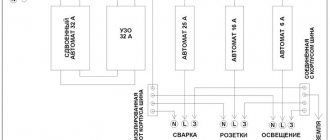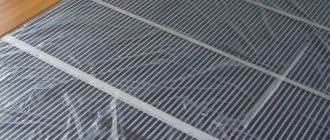Grounding an apartment plays a significant role for residents and equipment. The need for grounding may arise both for the entire apartment and for individual electrical appliances. Typically, this question arises when a partial or complete replacement of wiring is planned.
This problem can be solved in several ways. It all depends on the conditions, capabilities and preferences. The main thing is that the chosen method meets all safety standards. Possible options and their subtleties are described below, as well as which methods should not be used at all.
Features of grounding in an apartment
Most of the buildings were erected in Soviet times, and at that time there was no question of grounding in the apartment. People used a minimal number of electrical appliances and simply did not need it. The electrical wiring was two-wire, and three-phase connectors simply did not exist.
Now every apartment needs grounding, regardless of the age of the building. Before tackling this issue, you need to know several rules that differ for new buildings and old houses.
Grounding for a new building
There are several electrical systems in place for new homes. And before making grounding, you need to clarify what type you have:
- TN-CS - in this system, in addition to three phase wires L, there is a working zero N and a separate safety ground wire PE;
- TN-S – neutral wire N and safety grounding PE are independent of each other. The electrical wiring of the panel in the entrance is similar to the TN-CS system.
The whole process boils down to the fact that a grounding wire is laid around the apartment, after which sockets along with grounding are installed in the rooms, and a potential equalization system (PES) is installed in the bathroom.
Connection process:
- The phase wire is connected to the bus where the old one was.
- The working N-wire is connected to the neutral bus.
- Grounding PE wire to the panel.
Peculiarities:
- It is forbidden to connect all the grounding wires in the panel to one bolt. It is better to use several clamps. It is optimal to use the bus; it is screwed to the shield and the PE wire is connected.
- Three-phase input requires the same cross-section of all conductors. A maximum of two conductors of the same cross-section are connected to one terminal of the machine.
- The cross-section of the PE conductors should be 2.5 square meters. mm with mechanical protection, without it - 4 sq. mm. The cross-section of the conductor passing from the DSUP bus to the PE floor panel bus should be 6 sq. mm.
- If possible, the connection of the lighting and power circuits should be separate, but mixed power can also be used.
Lines directed to power units (oven, washing machine) are carried out individually.
Grounding in an old house
In older housing, the TN-C system is used. Here, zero N and protective grounding PE are combined under one conductor PEN. There is no grounding provided in the system at all. To reduce costs, energy companies ground the neutral conductor near the house, dividing it into neutral conductor N and protective grounding PE.
Self-grounding of housing is prohibited, since stray currents may occur. Only rewiring the entire house to use the TN-CS or TN-S system will help. Experts recommend installing a separate RCD system on large household appliances. This will not protect against electric shock, but will significantly reduce its strength.
DIY grounding devices: diagrams and examples
As an example, let’s take the successful experience of a grounding device, carried out on the basis of an officially certified project, tested and approved for operation.
For a grounding device it is necessary:
Machine and welding helmet. Two shovels (scoop and bayonet). Hammer or sledgehammer. Steel angles. Steel rod. Wires. Electrodes. Corrugated pipe. Terminal.
For example, let's take a private house.
We mark the points at a distance of 1.5 meters from each other, hammer in 3 steel corners. between which we hammer in electrodes at a distance of 1.5 meters - 3 steel, 3-meter corners. The corners are driven in vertically, recessed to 50%! g (MISSING) of the depth of the dug ditch (about 50 cm from ground level). The ditch is dug in the shape of a triangle.
The corners are welded to electrodes driven into the ground, all planes are properly welded with a welding machine. After this, it is necessary to measure the grounding resistance.
Note! The maximum permissible resistance level is 30 ohms.
After checking the resistance, we proceed to weld the metal rod to the corner of the ground loop. The rod is laid to the house. After this, it needs to be lifted under the pediment and connected to the shield.
Using bolts, we connect it to the panel body and distribute it among electrical appliances and sockets, and fill the excavated soil into the ditch.
Let's look at another example.
To set up this system you will need:
grounding stakes; metal jumpers for combining stakes; transmission lines from the circuit to the shield.
The diagram shows the most popular grounding model:
4
Grounding for a group of outlets
At the moment, manufacturers have already produced a large number of affordable European and American sockets. But in the CIS and Europe, the most common is the European type. They have a “phase”, “zero”, as well as a grounding contact that protrudes from the housing by 4-5 mm.
In fact, diverting electricity from outlets is a very important step, without which no existing premises can do. For strong and reliable protection of sockets, you will need a screwdriver, electrical tape, pliers and a special cable that must be connected to the grounding contact on the reverse side.
We recommend: Water pump for heating: consider water pumps for heating a private home
European-type sockets have a grounding contact that protrudes from the body by 4-5 mm
It is the connection of the cable to the contact that makes the outlet grounded and absolutely safe for all residents. This is a very easy job that absolutely anyone can handle. You just need to study a few manuals or learn more from a specialist.
But it is strongly recommended to delegate the work to a specially trained person who can reliably and safely ground the outlets in your apartment. After all, manual intervention in the electrical system may not end entirely favorably.
Grounding options
Modern electrical appliances require the use of sockets only with grounding. Those residents who do not have it in their apartment should think about this issue. There are several methods: an RCD system and a grounding loop; the final choice depends on the electrical energy distribution system operating in a particular house.
How to properly make a grounding loop
The essence of the method is simple, but it requires a responsible approach and care. A single-core PE wire is pulled to the basement along the riser. Three metal corners are driven in next to the house and connected by a plate. A wire is supplied to the structure from the floor, the other end is fixed in the panel. The wire is selected to be copper, with a cross-section of more than 4 sq. mm. All that remains is to connect the grounding of the apartment to the panel and the system is ready.
This method is carried out only by prior agreement with the management company. Otherwise, you may encounter difficulties.
RCD installation
The residual current device does not solve the grounding problem, but turns off the power supply at the moment of current leakage, which avoids shock or fire of household appliances.
The RCD is connected immediately after the meter and its installation requires compliance with certain standards:
- the neutral wire is always connected to the N-terminal of the device;
- The connection is made sequentially after the introductory machine. Please note that the rated current of the input circuit breaker must be less than the RCD.
It is better to install an RCD separately on each power supply line. This method will protect you from a complete power outage in the entire house if there is a breakdown on one line. But connecting multiple devices can cause problems. This is noticeable in houses with old construction, when the RCD system turns off the electricity falsely.
Dangerous protection schemes
These include:
- connection in the socket of the neutral with the grounding conductor;
- serial grounding of electrical appliances;
- connecting the third wire to a water pipe;
- connecting several wires to one terminal of the PE bus.
Such methods do not provide the necessary protection, but only harm. When creating grounding at home, do not forget about responsibility for the lives of loved ones.
Grounding by installing a metal circuit
Grounding in an apartment can be done with your own hands using special equipment - a metal grounding loop. This option will secure the power supply circuit not in a single 36 square meters - the situation will be corrected in the entire old house.
Metal circuit installation diagram
When implementing this option, it is important that two factors coincide. Housemates should be responsible owners who are ready to jointly solve the problem that has arisen. In addition, the management of the HOA or management company should support the idea of making such changes to the power supply scheme. And not just support - provide documentary assurance so that no problems or questions arise later.
Organization of grounding according to the TN-C scheme
Most often, you have to do a major overhaul, which involves replacing all the wiring in order to install sockets with grounding. A two-core aluminum cable does not meet modern safety requirements. The old housing stock was powered by TN-C. If the scutes have been preserved to this day, you can notice the absence of a yellow-green vein in them.
To secure all outlets, the wiring in the room is changed from a two-wire circuit to a three-wire circuit.
To disconnect/connect the power supply to the entrance, you must call service electricians. When the cable and sockets are replaced, the grounding wire must be output to the machine, similar to the description of TN-CS. After checking the circuit with a voltmeter, connect the housing to the network in accordance with GOST.
Some try to ground themselves the old fashioned way - to cold water pipes, heating pipes and, worst of all, to a gas pipe. There is no guarantee that contact will not cause a life-threatening discharge.
It is quite simple to carry out grounding yourself in an apartment building. But it is important to have at least a general understanding of connection diagrams and follow safety precautions. If grounding is not provided at all in an old building, it is recommended to completely replace the electrical wiring centrally using the TN-CS option.
Option through the plumbing or heating system: especially dangerous
Many men prefer to solve electrical issues themselves. And therefore, without further ado, they don’t bother too much with arranging grounding in the apartment. Throw a protective wire around the room, connecting it to the heating system or water supply. This option is suggested on many forums where fellow self-taught electricians sit. Not a single competent specialist will recommend this method of arranging grounding.
Household appliances and devices connected to water or heat may fail and electrocute the owner.
What does this mean? Any unforeseen situation - and the water in the tap may begin to shock. And this is just one of the few options for the development of events.
When rebuilding the power supply system of a home, you need to remember that an apartment building is a single mechanism.
The heating system and plumbing service the entire house, which means that all residents may suffer from the negligence of a particular technician. Household appliances and devices connected to water or heat may fail and electrocute the owner.
In the first chapter of the “Rules for Electrical Installations” there is a separate section devoted to grounding and protective electrical safety measures, which indicates the inadmissibility of such a scenario. In addition, you cannot ground electrical appliances through each other, or connect several wires to one terminal of the protective conductor bus.
Today it is simply impossible to do without grounding in an apartment's power supply system . If for some reason engineers designed the house without it, you need to ground the system yourself. Moreover, it is not difficult to do this.
Published: 03/19/2021
Share: Facebook
- Previous entryMain features of the procedure for replacing sockets and an electric meter in an apartment
- Next entryThe main thing is safety: we install wiring in a wooden house with our own hands according to all the rules
Common grounding circuits
- The most popular TN-C circuit , it is quite reliable, the protection is combined with the “zero” in the PEN core. The panel shows 4 cables, including 3 phases and PEN, 2 lead to the apartment. Instead of zeroing, AB (automatic shutdown) is activated.
- Slightly different from the previous circuit type TN-S, where PE and N are separated, leading from the apartment to the transformer substation (TS). To verify whether the current is supplied exactly according to this scheme, you need access to the transformer booth (enclosed space), but a housing and communal services worker can answer this question. There should be 5 wires, including neutral phase and PE,
- In the unified TN-CS system, N and PE are combined, but separated into ASUs. This ordering of the connection is important to avoid combining the “zero” with grounding. Houses are transferred to such a circuit after major repairs and when modernizing obsolete electrical equipment. In residential buildings, such a connection is fraught with emergency situations and electric shock, therefore it is forbidden to connect the protective and working wires to one bus.
- TT - with voltage supply through 4 wires, including “0” and three working phases, where everything is already neutralized at the entrance to the building. This scheme is considered optimal for a private house located in isolation.
- IT - the neutral wire is isolated from the ground, electricity flows through three wires. The circuit is simple, but it must be equipped with an automatic RCD (residual current device). You also need high-quality insulation. This option is used when providing installations with a continuous power supply.
Only certain old-style electrical appliances can be grounded, since new ones already have this option. Convenient to combine with the TN-CS circuit and a differential circuit breaker. The best conductor in this case is the non-flammable cable VVG(NG).
When connecting conductors, their cross-section must be the same. It must match the workload of its type of electrical engineering. It is recommended to connect the electrical wiring from the RCD directly to the device and through sockets protected from moisture.
Popular grounding systems
There are several options for arranging a grounding system. The standards and requirements for them are listed in the PUE - rules for the construction of electrical installations. All existing systems are marked in a certain way. For example, TN-C is a grounding system common in old residential buildings.
It is characterized by a low level of security. When organizing this option, the protective wire is connected to the working one. There is no separate grounding conductor in the circuit. There are also TN-S, TN-CS, TT, IT systems. In new buildings the following options are used: TN-S and TN-C-S. In this case, the wiring is laid with a three-core cable, providing a dedicated grounding. Read more about grounding systems.











